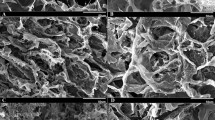Abstract
A novel nerve repairing material poly [LA-co-(Glc-alt-Lys)] (PLGL) was synthesized. The viability and growth of Schwann cells (SCs) co-cultured with poly (D, Llactic acid) (PDLLA) films (control group) and PLGL films were evaluated by MTTassay and SEM observation. Then, contact angle measurement, histological assessment and enzyme-linked immunosorbent assay (ELISA) testing on inflammatory-related cytokines such as IL-10 and TGF-β1 were performed. The results showed that, compared with PDLLA, PLGL films possesses better hydrophilicity, biocompatibility, degradation property and less inflammatory reaction. The present study indicated that PLGL scaffolds would meet the requirements of artificial nerve scaffold and have a potential application in the fields of nerve regeneration.
Similar content being viewed by others
References
Afshari F T, Kwok J C, White L, et al. Schwann cell migration is integrin-dependent and inhibited by astrocyte-produced aggrecan. Glia, 2010, 58(7): 857–869
Zhu X, Yao L, Yang X, et al. Spatiotemporal expression of KHSRP modulates Schwann cells and neuronal differentiation after sciatic nerve injury. The International Journal of Biochemistry & Cell Biology, 2014, 48(48): 1–10
Wan Z-T, Yin Y-X, Wang Y-H, et al. Research on the release of nerve growth factor from PNGF nerve repair material in vitro. Journal of Wuhan University of Technology, 2010, 32(12): 19–21
Phillips J B, King V R, Ward Z, et al. Fluid shear in viscous fibronectin gels allows aggregation of fibrous materials for CNS tissue engineering. Biomaterials, 2004, 25(14): 2769–2779
Barnett S C, Roskams A J. Olfactory ensheathing cells: isolation and culture from the neonatal olfactory bulb. Methods in Molecular Biology, 2008, 438: 85–94
Karimi M, Biazar E, Keshel S H, et al. Rat sciatic nerve reconstruction across a 30 mm defect bridged by an oriented porous PHBV tube with Schwann cell as artificial nerve graft. ASAIO Journal, 2014, 60(2): 224–233
Martin I, Nguyen T D, Krell V, et al. Generation of Schwann cellderived multipotent neurospheres isolated from intact sciatic nerve. Stem Cell Reviews, 2012, 8(4): 1178–1187
Sedaghati T, Jell G, Seifalian A. Investigation of Schwann cell behaviour on RGD-functionalised bioabsorbable nanocomposite for peripheral nerve regeneration. New Biotechnology, 2014, 31(3): 203–213
Tao Y. Isolation and culture of Schwann cells. Methods in Molecular Biology, 2013, 1018: 93–104
Spiller K L, Anfang R R, Spiller K J, et al. The role of macrophage phenotype in vascularization of tissue engineering scaffolds. Biomaterials, 2014, 35(15): 4477–4488
McAlvin J B, Padera R F, Shankarappa S A, et al. Multivesicular liposomal bupivacaine at the sciatic nerve. Biomaterials, 2014, 35(15): 4557–4564
Bailey A, van Hateren A, Elliott T, et al. Two polymorphisms facilitate differences in plasticity between two chicken major histocompatibility complex class I proteins. PLoS One, 2014, doi: 10.1371/journal.pone.0089657
Ni B, Jia Z, Wu Y. Preparation of polypeptides comprising multiple TAA peptides. Methods in Molecular Biology, 2014, 1139: 357–366
Atkins S, Loescher A R, Boissonade F M, et al. Interleukin-10 reduces scarring and enhances regeneration at a site of sciatic nerve repair. Journal of the Peripheral Nervous System, 2007, 12(4): 269–276
Taskinen H S, Olsson T, Bucht A, et al. Peripheral nerve injury induces endoneurial expression of IFN-γ, IL-10 and TNF-α mRNA. Journal of Neuroimmunology, 2000, 102(1): 17–25
Zhou L, Lopes J E, Chong M M, et al. TGF-β-induced Foxp3 inhibits T(H)17 cell differentiation by antagonizing RORgammat function. Nature, 2008, 453(7192): 236–240
Norden DM, Fenn AM, Dugan A, et al. TGFβ produced by IL-10 redirected astrocytes attenuates microglial activation. Glia, 2014, doi: 10.1002/glia.22647
Veldhoen M, Uyttenhove C, van Snick J, et al. Transforming growth factor-β ‘reprograms’ the differentiation of T helper 2 cells and promotes an interleukin 9-producing subset. Nature Immunology, 2008, 9(12): 1341–1346
Dardalhon V, Awasthi A, Kwon H, et al. IL-4 inhibits TGF-β-induced Foxp3+ T cells and, together with TGF-β, generates IL-9 + IL-10+ Foxp3(−) effector T cells. Nature Immunology, 2008, 9(12): 1347–1355
Author information
Authors and Affiliations
Corresponding author
Additional information
Y.X.Y. and J.L.Y. contributed to this paper equally.
Rights and permissions
About this article
Cite this article
Yin, YX., Yi, JL., Xie, LJ. et al. Synthesis, characterization and biological evaluation of poly [LA-co-(Glc-alt-Lys)] for nerve regeneration scaffold. Front. Mater. Sci. 8, 95–101 (2014). https://doi.org/10.1007/s11706-014-0239-7
Received:
Accepted:
Published:
Issue Date:
DOI: https://doi.org/10.1007/s11706-014-0239-7



